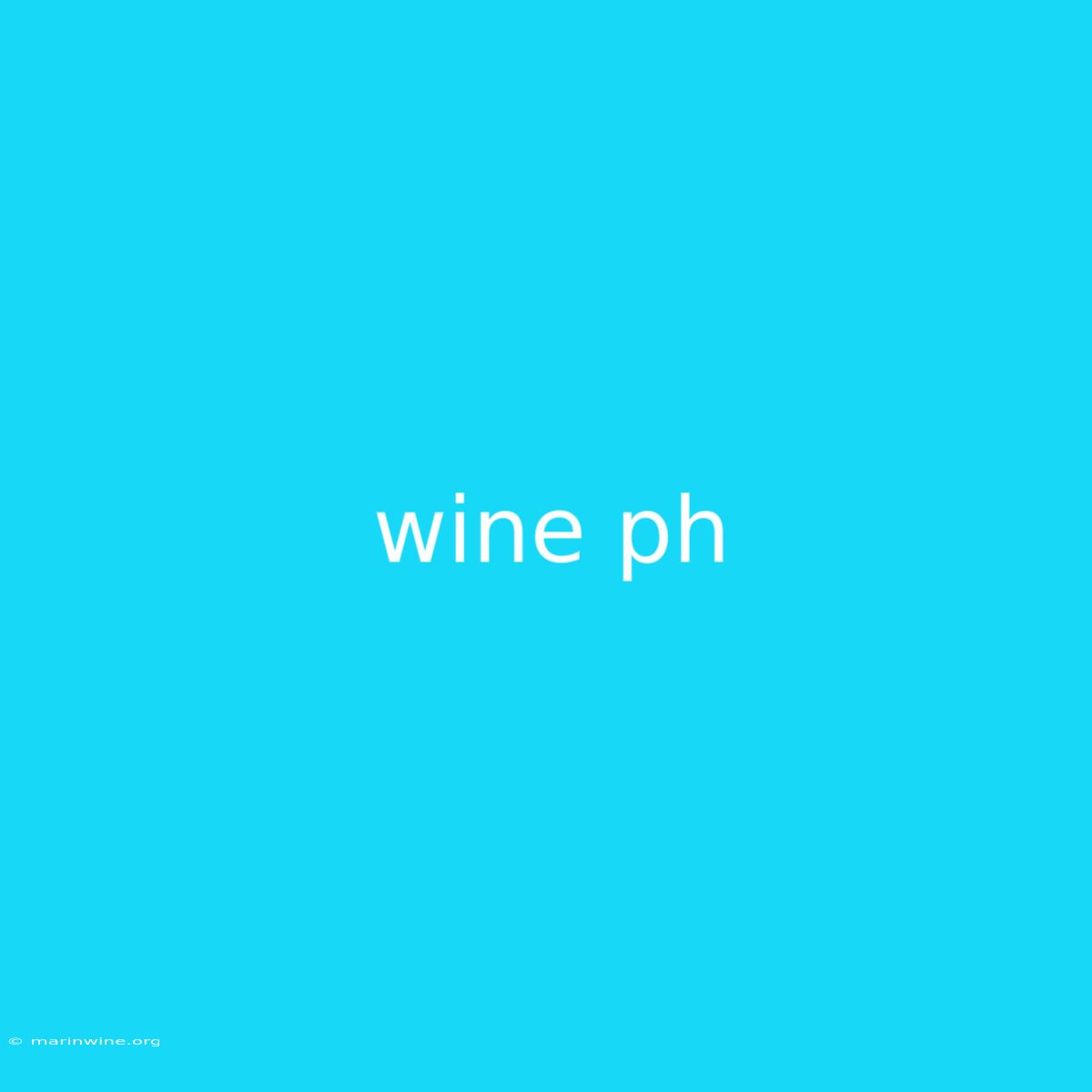Uncorking the Mystery: A Deep Dive into Wine pH
Have you ever wondered why some wines taste crisp and refreshing, while others are rich and full-bodied? The answer lies, in part, within the wine's pH.
Why It Matters: Wine pH is a critical factor influencing its flavor, stability, and overall quality. Understanding this intricate aspect of winemaking is essential for both connoisseurs and winemakers alike. This article delves into the world of wine pH, exploring its importance, measurement, and impact on the final product.
Key Takeaways of Wine pH
| Aspect | Description |
|---|---|
| Definition | Wine pH refers to the acidity or alkalinity of the grape juice and ultimately the finished wine. |
| Ideal Range | Most wines have a pH between 3.0 and 3.5, with red wines generally having a slightly higher pH than whites. |
| Impact on Flavor | pH affects the perceived acidity, fruitiness, and tannins of the wine. |
| Stability | A stable pH contributes to the wine's shelf life and resistance to microbial spoilage. |
Wine pH: A Deeper Dive
What is pH?
pH, meaning "potential of hydrogen," is a measure of a solution's acidity or alkalinity. It is expressed on a scale of 0 to 14, with 7 being neutral, values below 7 indicating acidity, and values above 7 indicating alkalinity.
Why is pH Important in Winemaking?
Wine pH plays a crucial role in influencing various aspects of the winemaking process and the final product:
1. Taste and Flavor:
- Acidity: A lower pH (more acidic) wine will taste crisper and more refreshing, while a higher pH (less acidic) wine will be softer and fuller-bodied.
- Fruitiness: pH influences the expression of fruit flavors, with higher pH wines often exhibiting more pronounced fruit notes.
- Tannins: pH affects the astringency of tannins, with lower pH wines often having more pronounced tannins.
2. Stability:
- Microbial Spoilage: Lower pH wines are less susceptible to microbial spoilage, as most bacteria and yeast prefer higher pH environments.
- Color Stability: In red wines, pH influences color stability and the development of complexity.
- Shelf Life: A stable pH contributes to a longer shelf life for the wine.
3. Winemaking Process:
- Yeast Fermentation: pH affects the yeast's activity during fermentation, influencing the rate of sugar conversion to alcohol.
- Malolactic Fermentation: This secondary fermentation, common in red wines, is influenced by pH.
4. Wine Style:
- Regional Variations: Winemaking regions often have specific pH ranges that are considered optimal for their grape varieties and desired wine styles.
pH and Winemaking Techniques
1. Winemaking Techniques to Influence pH:
- Grape Selection: Some grape varieties naturally have higher pH than others.
- Harvest Date: Grapes harvested later in the season tend to have a higher pH.
- Acidification: Adding acid (e.g., tartaric acid) can lower the pH of the grape juice.
- De-acidification: Removing acid (e.g., using calcium carbonate) can raise the pH.
2. Measuring pH:
- pH Meter: A digital pH meter provides the most accurate and reliable measurement.
- pH Paper: A quick and inexpensive way to measure pH, although not as precise as a pH meter.
The Connection Between pH and Wine Quality
While a specific pH value doesn't guarantee quality wine, a balanced pH within the optimal range contributes significantly to the overall quality and stability of the wine.
High pH can lead to:
- Less pronounced acidity
- Greater susceptibility to microbial spoilage
- Less vibrant color in red wines
Low pH can lead to:
- Excessive tartness
- Potential for bitterness
- Accelerated aging
Example:
A red wine with a high pH might have a softer, more fruit-forward profile but may be more prone to oxidation and loss of color over time. Conversely, a white wine with a lower pH might be crisp and refreshing but could be perceived as overly tart by some drinkers.
FAQ for Wine pH
Q: How can I tell if a wine has a high or low pH without using a meter? A: While not a precise indicator, you can get a general idea by tasting the wine. A wine with a higher pH will taste softer and less acidic, while a wine with a lower pH will be more tart and refreshing.
Q: Does wine pH change over time? A: Yes, wine pH can change slightly over time due to oxidation, interactions with the bottle, and other factors.
Q: How can I use pH to improve my winemaking? **A: ** Monitoring pH during the winemaking process is crucial. You can use acidification or de-acidification techniques to adjust the pH and achieve the desired style and quality in your wine.
Q: Is it possible to taste the difference in pH between different wines? A: Yes, you can often detect the difference in acidity levels, which is directly influenced by pH, between wines.
Q: Can a winemaker deliberately manipulate pH to create a specific flavor profile? A: Yes, winemakers have various tools at their disposal to adjust pH, such as adding acids or using de-acidification techniques, to influence the final flavor of the wine.
Tips for Wine pH
- Understand Your Grape Variety: Research the ideal pH range for your grape variety.
- Monitor pH Throughout the Winemaking Process: Use a pH meter for accurate measurements.
- Adjust pH When Necessary: Use acidification or de-acidification techniques to achieve optimal pH.
- Consider Your Target Wine Style: The desired style of wine will influence the desired pH range.
Summary of Wine pH
Wine pH is a critical factor that significantly influences the flavor, stability, and overall quality of wine. Understanding pH allows winemakers to make informed decisions about their winemaking techniques, ensuring they achieve the desired style and quality.
Closing Message: While pH is just one piece of the complex puzzle that is winemaking, it plays a vital role in shaping the final product. By understanding and managing pH, winemakers can create wines that are both delicious and well-balanced.

